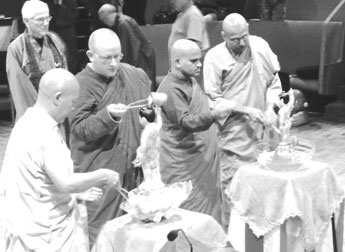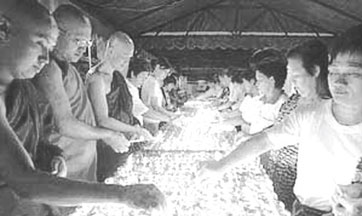Buddhist festivals around the world
by Premasara EPASINGHE
Today, Buddhism is a world religion with about six billion followers.
It is not only a religion, but also a great philosophy.
 Not
a single phase of Buddhist history has ever been lurid with the light of
inquisitorial fires, or darkened with the smoke of heretic or heathen
cities ablaze or red with blood of the guiltiness victims of religious
hatred. Not
a single phase of Buddhist history has ever been lurid with the light of
inquisitorial fires, or darkened with the smoke of heretic or heathen
cities ablaze or red with blood of the guiltiness victims of religious
hatred.
Buddhism wields one sword. It is the sword of wisdom - recognise only
one enemy - ignorance. When we read Buddhist discourses, we are
impressed by His sprit of reason. His ethical path has for its first
step right views, a rational outlook.
There is a great diversity in the range of Buddhist ceremonies and
festivals. They follow the lunar calendar. Buddhism has spread into many
countries. They are inter-woven to their cultures.
The rituals, ceremonies, festivals differ from one country to
another. Basically, Buddhist ceremonies can be divided into two main
groups.
They are Theravada and Mahayana.
According to the Western calender, in Sri Lanka and Thailand, the New
Year falls on April 13 or 14. In Burma or Myanmar it is on April 16.
It is the season for visiting relations, friends, give presents.These
ceremonies have their traditions and customs.In Sri Lanka, the main
Buddhist ceremonies are held on Vesak (May), Poson (June), Esala (July)
and Vap (October). It begins with Duruthu (January) ends in Navam
(February).
Ceremonies
 In
Sri Lanka important Buddhist religious festivals held between
July-August are called Esala. It marks the deliverance of Buddha’s first
sermon “Dhamma Chakkapavattana Sutta” turning of the wheel of law. In
Sri Lanka important Buddhist religious festivals held between
July-August are called Esala. It marks the deliverance of Buddha’s first
sermon “Dhamma Chakkapavattana Sutta” turning of the wheel of law.
The Kandy Esala Perahera, a procession in which the Sacred Tooth
Relic of the Buddha is carried.
The other important events are rain retreat (Vas) ceremony which is
performed in June/July and October/November respectively.
In Thailand, the main Buddhist festival known as Loi Karatong is held
on the Full Moon Poya Day in November. It is centred on temples. It is a
festival of lights. The temples and the houses are decorated with palm
leaves, banana stalks, coloured lanters, lamps, candles and flags.
Another important Buddhist event performed in Thailand is called the
Magha Puja.
It signifies All Saints Day or “Dharma Day”, which commemorates an
event three months prior to the Buddha’s passing away.
Tibetan festivals
Tibetan Buddhism is found today even in India, across Europe and U.S.
The 14th Dalai Lama is the head of Buddhist activities in Tibet.
He resides with Tibetan Bhikkhus in Dharmasala Palace at the
foothills of beautiful snowy Himalayas.
The Tibetan New Year, which falls in February is called Losar - which
commemorate the Buddha’s early life upto the Enlightenment.
Tibetan bhikkhus perform the great prayer called Monlam Cheam. The
fifteenth day is the Full Moon Day known as Chongo Chopa.
They celebrate the important events of the Buddha’s life. They have
puppet shows too, on a Buddhist theme.
There are two chapters of bhikkhus - Upper Tantric School (Gyuto) and
Lower Tantric School (Gyume). The two famous monastries are responsible
for the Buddhist displays.
They are now located in India and the religious celebrations take
place in Dharmasala.
Devils
On the 29th day of the month of the old year, ushering Lasar, New
Year begins. There are family gatherings. Together, they partake special
nine soup - called Gutuk.
The left overs are carried by men to a lonely spot in the night with
torch lights, calling the Devils to “come out” - “come out”.
Following this a procession of monks carries “constructions” which
they call special New year Zor Tormas - community bad karma of the
previous year.
Later, they burn the constructions.
In the New Year religious ritual, you can see a lot of coloured
prayer flags and Tibetan Instruments.
The 15th of the fourth month, the Full Moon Day, May, the Tibetans
celebrates the Buddha’s birth, Enlightenment and Parinibbana.
This is known as the festival of Saga Dawa. Devout Buddhists, take
vows to fast and be silent for seven days.
On the fifth month (June) on Full Moon Poya Day, they celebrate the
Dzamling Chisang - fire offerings to the spirits. Favourite Tibetan
vegetarian dishes are offered to the spirits. Offerings are made by
laymen, and they abstain from meat for three days before hand.
Matrudevi
On October 22, Tibetan celebrate the Buddha’s descent to this world
after preaching to “Matrudevi” - Buddha’s mother Mahamaya who resides in
Thusita Heaven. It is known as Lhabap.
The Tibetans celebrate the anniversary of Tsohakhapa on November 25.
He is the founders of Yellow Hat School of Tibetan Buddhism.
Then, they celebrate the birth anniversary of Guru Rimpoche’s
(Precious Guru) - Padma Sambhava - an Indian, prof who brought Buddhism
to Tibet. His birthday was in July. As a mark of respect and pay
gratitude, Tibetans celebrate his birthday.
In Sanskrit, Chinese, Japanese and Vietnamese languages Buddhas are
called Shih-Chia-Fo (Chinese) Shakamuni (Japanese) Thich - Ca-Mau-Ni
(Vietnamese) Sakaymuni (Sanskrit-India).
The Buddha Amitasha was known as O-Mi-To-Fo (Chinese), Amida
(Japanese), A-Di-Da-Phat (Vietnamese).
Vairocana is the Sanskrit name for the Buddha. The other names in
Chinese, Japanese and Vietnamese were P’I-Lo Fo, Danchi,
Ty-Lo-Gia-Na-Phat (Dai Nhat) respectively.
In the of Bodhisattavas, the four names used in Sanskrit -
Avalokitesvara - Chinese Kuan-Yin, Kannon (Japanese) Quan.
The-am (Vietnamese) for Maitreya is the Sanskrit word used. In
Chinese the term is Mi-Lei, Japanese Sei-Shi, Vietnamese Di-Lac-Bo Tat.
Japan received the gift of Buddhism via China. Therefore, the
Buddhist festivals of these countries are very much similar.
Enlightenment
The Buddha’s Enlightenment and Parinibbana, on April 8, according to
the Chinese calendar, is celebrated in Japan too. It is known as Hana
Masturi.
According to Mahayana tradition, Samsara - (the relentless cycle of
repeated birth and death is divided into various realms. The realm of
“hungry ghost” is one of them.
Moggallana Thera, one of the chief disciples (The other was Sariputra)
saved his mother from hell. It is stated that he offered alms to the
Buddhas and bhikkhus.
By this virtue, Mahayanist believe that the Buddha pulled Moggalana
Thera’s mother from hell using a rope.
Pretha
Prof. Gunapala Malalasekera defines the word “Preta” as the ‘departed
one.’ In Sri Lankan Buddhist funerals, bhikkhus bestow merit to on the
dead.
In a religious ceremony conducted in front of the coffin, while
pouring water on a bowl, before the body is cremated, buried or offered
to a university medical faculty, bhikkhus chant pali stanzas According
to the stanza, anyone who crosses over to the other world is known as
Pretha”.
The Western Buddhist festivals are Buddhist Day (May), Dhamma Day
(July) and Sangha Day (November). Most Buddhists in western countries
and in America devote more time for Bhavana or meditation. |

